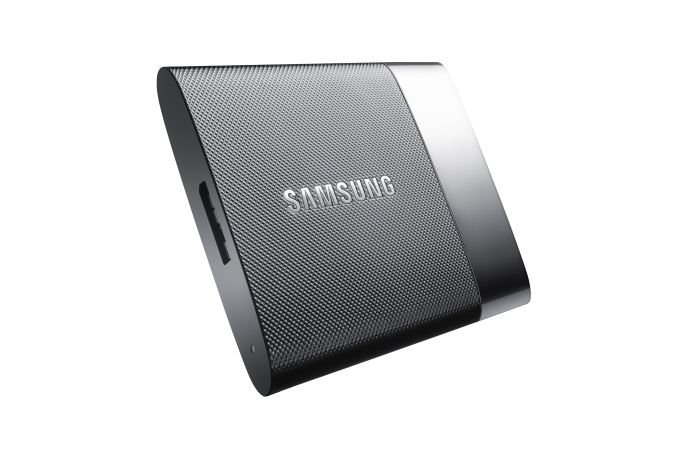Samsung Releases External T1 SSD
by Kristian Vättö on January 5, 2015 5:00 PM EST
Traditionally the external flash storage space has been run by so called second tier OEMs that basically just buy the controller and NAND from third parties and then do the chassis design and assembly on their own. With the introduction of the T1, Samsung becomes the first tier one manufacturer to enter the external SSD market. Hardware wise the T1 is based on the 850 EVO, meaning that the T1 uses 32-layer TLC V-NAND and the same full-fledged MEX/MGX SSD controller. The housing is considerably smaller than a regular 2.5" chassis, though, making the T1 a very portably solution (although a USB stick would be even more portable, but fitting and cooling a full SSD controller in such design is fairly difficult).
The T1 support USB 3.0 UASP mode for increased performance and for sequential performance Samsung is promising up to 450MB/s. Random performance comes in at 8K IOPS for read and 21K for write. There is also AES-256 encryption support, which is definitely handy for business users that handle sensitive data. The drive comes pre-formatted as exFAT to ensure out-of-the-box compatibility with both Windows and OS X based systems.
The available capacities will be 250GB, 500GB and 1TB with the MSRPs being $180, $300 and $600 respectively and a 3-year warranty. The pricing is definitely a bit high, but since we are dealing with MSRPs things can change very quickly and I wouldn't draw any final conclusions yet. I have samples waiting for me when I get back, so stay tuned for our review in the next few weeks.










22 Comments
View All Comments
jgstew - Monday, January 5, 2015 - link
It would be helpful to link to the product page: http://www.samsung.com/global/business/semiconduct...Kristian Vättö - Monday, January 5, 2015 - link
The product page was not up when I wrote the post last night (there was an NDA), so I couldn't link to it.galfert - Monday, January 5, 2015 - link
So how will this handle TRIM? I've yet to see an SSD support TRIM that is connected via USB.Kristian Vättö - Monday, January 5, 2015 - link
TRIM is part of the ATA command set, which USB doesn't support, so I don't think any external SSD can properly handle TRIM in any case. I can try to dig up more about that for the review, though.baii9 - Monday, January 5, 2015 - link
msata + msata to usb enclosure, boom...
and no trim unless samsung pull some magic.
hpglow - Tuesday, January 6, 2015 - link
The firmware can't trigger garbage collection when it detects an idle state? TRIM is a load of crap. It was a fill gap for proper firmware garbage collection. There its a reason why the enterprise didn't give 2 shits about it.hojnikb - Tuesday, January 6, 2015 - link
trim is far from load of crap. Even with the best garbage collection, firmware still won't know which data is invalid (ie marked as deleted by filesystem), so ready for being erased.baii9 - Tuesday, January 6, 2015 - link
build in GC should be good enough for a portable drive use, don't think people are gonna hammer a usb drive~name99 - Tuesday, January 6, 2015 - link
This is an idiotic statement, brought to us by the same idiotic mentality that has made USB disks the PoS they have been for so long (eg no SMART access to USB drives, and no NCQ).It is perfectly reasonable for people to want to replace or augment the internal drive of an existing computer with a USB SSD. On OS X, for example, the possibilities include
- the internal drive has died and so you use a USB SSD as a boot drive OR
- create a fusion drive from the SSD and the internal drive.
I've done this on multiple different occasions, sometimes the first situation, sometimes the second, to give a shot of life into a mac that's 7 or 8 years old.
People complain all the time about Apple supposedly inventing their own specs like Lightning, but then refuse to admit (and FIX) the crappiness in existing specs...
Samus - Tuesday, January 6, 2015 - link
Odds are they're have some special implementation in Samsung Magician to zero-fill the drive empty space with raw data then delete the raw data, triggering the controller to start garbage collection. Intel drives have used this strategy for years in Intel SSD Toolbox.